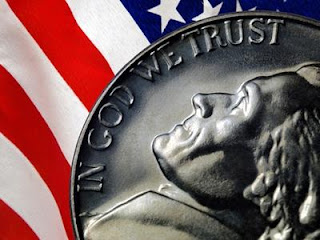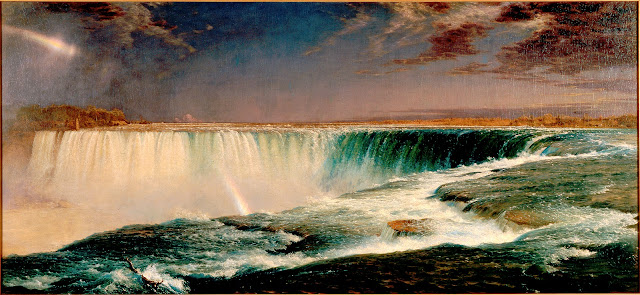
Frederic Edwin Church,
Twilight in the Wilderness, 1860
Reading the news a few weeks ago, I discovered that the British
government had placed a temporary export bar (expiring 7th April) on Jasper Francis Cropsey's
painting Richmond Hill in the Summer of
1862. The
government needs to raise almost £5 million to keep this canvas in the country.
Since the National Gallery has an unusual, related
exhibition currently
showing,
I think this is an important and easily overlooked moment in the spotlight for
American art in Britain.
The last English owned Hudson River School canvas, Frederic
Edwin Church’s The Icebergs (1861)
was allowed to leave England in 1990. According to Sotheby’s, Hudson River School
canvases are among the most consistently reliable for sheer monetary
appreciation. So it seems extraordinary on several counts that if Cropsey’s Richmond Hill is allowed to leave the
country we have only one representative canvas left in the UK.
If you visit the National Gallery in London before April 28th
you can see some beautiful oil sketches by Church and the perhaps soon to be
last canvas remaining in the UK, Church’s huge Niagara From the American Side canvas of
1867, which is on loan from its home in the National Galleries of Scotland in
Edinburgh. This is an extremely rare opportunity.
The most recent exhibition of these canvases outside the UK
was Tate Britain’s American Sublime exhibition in 2004, which brought many of
the most important Hudson River canvasses to London for the first time. Yet
transatlantic connections to the Hudson River School are strong, especially
between Thomas Cole, who was born in Lancashire but emigrated to the United
States as a teenager, and his student Frederic Edwin Church. So why are these
pictures so under-represented in British galleries?
A comparison of Cole and Church’s work quickly reveals Church’s
unprecedented deep personal familiarity with the American landscape. The oil
sketches on view in the National Gallery right now can evoke a sense of the
American geography without having to depict it in any detail, and the
sensational response his canvases elicited in the United Kingdom only
underscore to his power to represent the American landscape at a pivotal moment
in the nation’s history.
Frederic Edwin Church, Niagara,
1857
Church’s sketches from his travels to Labrador, Jamaica, the
Middle East, western Europe and the Andes highlight the cosmopolitan character and
international importance of American art in the Mid-nineteenth century, as well
as the physical extremes artists like Church and, later, Albert Bierstadt and
Thomas Moran went to to be the first to paint the North and South American
continents.
I’m working on American literature from the mid-nineteenth
century for my PhD, and especially given the dearth of photographs from this
time I personally find that these paintings form a striking visual context for their
contemporary literature. Church’s oil sketch of a campfire in the Maine woods was
made only a few months before Henry David Thoreau took an excursion in the very
same area, his account of which was later published in The Maine Woods. I like
to think they may have run into one another along the trails, or maybe the
campfire site was used by Thoreau’s group as they passed through..
The exhibition is free to view and is on display until 28th
April.
Joanne Mildenhall is a first year PhD student in the School of American
Studies. Her research centres on the study of philology, nationalism and
cultural hybridity in antebellum American literature, particularly in the work
of Henry David Thoreau.
Email: J.Mildenhall@uea.ac.uk

















